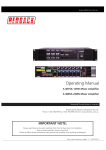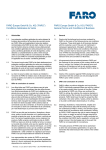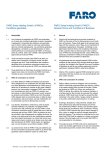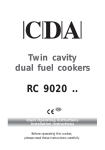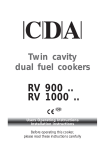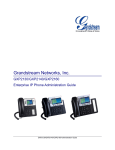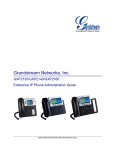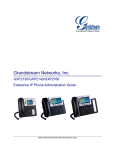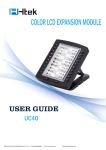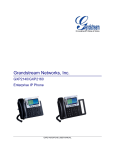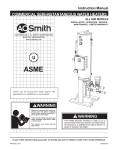Download A.O. Smith Hot Water Generator Technical Documents
Transcript
Instruction Manual HOT WATER GENERATING SYSTEMS VERTICAL AND HORIZONTAL MODELS HWG-140 THRU HWG-1000 INSTALLATION - OPERATION - SERVICE MAINTENANCE - LIMITED WARRANTY A DIVISION OF A. O. SMITH CORPORATION RENTON, WASHINGTON www.hotwater.com ASME Thank you for buying this water heater. We appreciate your confidence in our products. place these instructions adjacent to heater and notify owner to keep for future reference. PRINTED 0610 315823-001 SAFE INSTALLATION, USE AND SERVICE Your safety and the safety of others is extremely important in the installation, use, and servicing of this water heater. Many safety-related messages and instructions have been provided in this manual and on your own water heater to warn you and others of a potential injury hazard. Read and obey all safety messages and instructions throughout this manual. It is very important that the meaning of each safety message is understood by you and others who install, use, or service this water heater. This is the safety alert symbol. It is used to alert you to potential personal injury hazards. Obey all safety messages that follow this symbol to avoid possible injury or death. DANGER DANGER indicates an imminently hazardous situation which, if not avoided, will result in death or injury. WARNING WARNING indicates a potentially hazardous situation which, if not avoided, could result in death or injury. CAUTION CAUTION indicates a potentially hazardous situation which, if not avoided, could result in minor or moderate injury. CAUTION CAUTION used without the safety alert symbol indicates a potentially hazardous situation which, if not avoided, could result in property damage. All safety messages will generally tell you about the type of hazard, what can happen if you do not follow the safety message, and how to avoid the risk of injury. The California Safe Drinking Water and Toxic Enforcement Act requires the Governor of California to publish a list of substances known to the State of California to cause cancer, birth defects, or other reproductive harm, and requires businesses to warn of potential exposure to such substances. This product contains a chemical known to the State of California to cause cancer, birth defects, or other reproductive harm. This appliance can cause low level exposure to some of the substances listed. IMPORTANT DEFINITIONS • Qualified Installer or Service Agency: Installation and service of this water heater requires ability equivalent to that of a Qualified Agency (as defined by ANSI below) in the field involved. Installation skills such as plumbing and electrical supply are required in addition to electrical testing skills when performing service. • ANSI Z223.1 2006 Sec. 3.3.83: “Qualified Agency” - “Any individual, firm, corporation or company that either in person or through a representative is engaged in and is responsible for (a) the installation, testing or replacement of gas piping or (b) the connection, installation, testing, repair or servicing of appliances and equipment; that is experienced in such work; that is familiar with all precautions required; and that has complied with all the requirements of the authority having jurisdiction.” 2 GENERAL SAFETY INFORMATION PRECAUTIONS HYDROGEN GAS (FLAMMABLE) DO NOT USE THIS APPLIANCE IF ANY PART HAS BEEN UNDER WATER. Immediately call a qualified service technician to inspect the appliance and to replace any part of the control system which has been under water. If the unit is exposed to the following, do not operate heater until all corrective steps have been made by a qualified service agency. 1. 2. 3. External fire. Damage. Firing without water. GROUNDING INSTRUCTIONS This water heater must be grounded in accordance with the National Electrical Code and/or local codes. These must be followed in all cases. Failure to ground this water heater properly may also cause erratic control system operation on ELECTRONIC CONTROL models. Hydrogen gas can be produced in a hot water system served by this heater that has not been used for a long period of time (generally two weeks or more). Hydrogen gas is extremely flammable. To reduce the risk of injury under these conditions, it is recommended that the hot water faucet be opened for several minutes at the kitchen sink before using any electrical appliance connected to the hot water system. If hydrogen is present there will probably be an unusual sound such as air escaping through the pipe as the water begins to flow. THERE SHOULD BE NO SMOKING OR OPEN FLAME NEAR THE FAUCET AT THE TIME IT IS OPEN. This water heater must be connected to a grounded metal, permanent wiring system, or an equipment grounding conductor must be run with the circuit conductors and connected to the equipment grounding terminal or lead on the water heater. When servicing this unit, verify the power to the unit is turned off prior to opening the control cabinet door. 3 TABLE OF CONTENTS Safe Installation, Use and Service....................................2 General Safety INFORMATION.................................................3 ELECtrical data...........................................................................9 Precautions................................................................................3 General......................................................................................9 Hydrogen Gas (Flammable)......................................................3 Branch Circuit............................................................................9 Table of Contents.....................................................................4 Control Circuits..........................................................................9 Introduction...............................................................................4 Thermal Expansion (Closed System)........................................9 wiring diagrams.......................................................................10 Preparing for the Installation......................................................4 OPERATION....................................................................................11 features, components, and dimensions...........................6 TYPICAL WATER HEATER TRIM.....................................................6 APPROVALS.....................................................................................7 General Safety.........................................................................11 Initial Start-Up..........................................................................11 maintenance..............................................................................12 MODEL AND RATING.......................................................................7 General....................................................................................12 Tank Maintenance....................................................................12 installation.................................................................................8 Flushing...................................................................................12 Required Ability..........................................................................8 Sediment Removal............................................................ 12-13 Location.....................................................................................8 Checklist..................................................................................13 Installation Clearances..............................................................8 troubleshooting....................................................................14 Leveling.....................................................................................8 warranty....................................................................................15 Relief Valve................................................................................8 notes...................................................................................... 16-19 locating the new water heater..........................................7 Facts to Consider About the Location........................................7 INTRODUCTION Thank You for purchasing this water heater. Properly installed and maintained, it should give you years of trouble free service. The model and rating plate on page 7 interprets certain markings into useful information. Both of these references should be used to identify the heater, its components and optional equipment. Abbreviations Found In This Instruction Manual: • • • • Preparing for the Installation 1. Read the “General Safety” section of this manual first and then the entire manual carefully. If you don’t follow the safety rules, the water heater may not operate safely. It could cause DEATH, SERIOUS BODILY INJURY AND/OR PROPERTY DAMAGE. 2. The installation must conform with these instructions and the local code authority having jurisdiction and the requirements of the power company. In the absence of code requirements, follow NFPA-70 (current edition). The National Electrical Code may be ordered from: National Fire Protection Association, 1 Batterymarch Park, Quincy, MA 02269. 3. If after reading this manual you have any questions or do not understand any portion of the instructions, call the toll free number on the back cover for further assistance. A sample rating plate and barcode tag are shown on page 7 of this manual. In order to expedite your request, please have the serial number and item ID from the barcode tag available for the technician. 4. Carefully plan your intended placement of the water heater. Examine the location to ensure the water heater complies with the “Locating the New Water Heater” section in this manual. Clearance must be maintained so that the coil bundle may be removed for servicing after installation. Installation and service of this water heater requires ability equivalent to that of a licensed tradesman or qualified agency (page 2) in the field involved. Plumbing and electrical work are required. 5. For installation in California this water heater must be braced or anchored to avoid falling or moving during an earthquake. See instructions for correct installation procedures. Instructions may be obtained from California Office of the State Architect, 1102 Q Street, Suite 5100, Sacramento, CA 95811. 6. Massachusetts Code requires this water heater to be installed in accordance with Massachusetts 248-CMR 2.00: State Plumbing Code and 248-CMR 5.00. ANSI - American National Standards Institute ASME - American Society of Mechanical Engineers NEC - National Electrical Code NFPA - National Fire Protection Association This manual contains instructions for the installation, operation, and maintenance of the water heater. It also contains warnings throughout the manual that you must read and be aware of. All warnings and all instructions are essential to the proper operation of the water heater and your safety. READ THE ENTIRE MANUAL BEFORE ATTEMPTING TO INSTALL OR OPERATE THE WATER HEATER. General outline diagrams are in this manual. These diagrams will serve to provide the installer with a reference for basic installation of this product. IT IS NECESSARY THAT ALL WATER PIPING AND THE ELECTRICAL WIRING BE INSTALLED AND CONNECTED AS SHOWN IN THE DIAGRAMS. Be sure to turn off power when working on or near the electrical system of the heater. Never touch electrical components with wet hands or when standing in water. When replacing fuses always use the correct size for the circuit. Use same size and type of fuse when replacing. The principal components of the heater are identified on page 6. 4 FEATURES, COMPONENTS, AND DIMENSIONS 5 TYPICAL WATER HEATER TRIM FIGURE 3. TYPICAL STEAM TO WATER PIPING FIGURE 4. TYPICAL WATER TO WATER 3 WAY PIPING 6 APPROVALS ASME MODEL AND RATING LOCATING THE NEW WATER HEATER Facts to Consider About the Location Whether replacing an old water heater or putting the water heater in a new location, the following critical points should be observed. The water heater should be located: 1. On a level surface. Shim the channel type skid base as necessary if levelling is required. 2. Near a floor drain. The heater should be located in an area where leakage of the tank or connections will not result in damage to the area adjacent to the heater or to lower floors of the structure. 3. The discharge opening of the temperature and pressure relief valve should always be piped to an open drain. Installation of the water heater must be accomplished in such a manner that if the tank or any connections should leak, the flow will not cause damage to the structure. For this reason, it is not advisable to install the water heater in an attic or upper floor. 4. Close to the point of major hot water usage and the power supply. Water heater life depends upon water quality, water pressure and the environment in which the water heater is installed. Water heaters are sometimes installed in locations where leakage may result in property damage. However, unanticipated damage can be reduced or prevented by a leak detector or water shut-off device. These devices are available from some plumbing supply wholesalers and retailers: Insulate hot and cold water piping where heat loss and condensation may be a problem. Hot water piping and branch circuit wiring should be as short as possible. Heater construction permits installation, maintenance, and service work to be performed from the front of the unit. Ensure enough frontal clearance so that the piping and coil may be removed from the tank. Suggested clearances from adjacent surfaces are 12 inches on top, for access to the unit. Carefully choose a location for the new water heater. The placement is a very important consideration for the safety of the occupants in the building and for the most economical use of the equipment. The heater may be installed on or against combustible surfaces. The left side and back may be placed flush against adjacent surfaces. The water heater should be located in an area where the general public does not have access. If a suitable area is not available, a cover should be installed over the thermostat to prevent tampering. The temperature of the space in which the water heater is installed must not go below 32°F or above 122°F. 7 INSTALLATION Required Ability Installation or service of this hot water generator requires ability equivalent to that of a licensed tradesman in the field involved pipe fitting in the steam or boiler water is required. See Qualified Installer or Service Agency on page 2. temperature-pressure Relief Valve The Discharge Pipe: • Shall not be smaller in size than the outlet pipe size of the valve, or have any reducing couplings or other restrictions. • Shall not be plugged or blocked. • Shall be of material listed for hot water distribution. • Shall be installed so as to allow complete drainage of both the temperature-pressure relief valve and the discharge pipe. • Must terminate a maximum of six inches above a floor drain or external to the building. In cold climates, it is recommended that the discharge pipe be terminated at an adequate drain inside the building. • Shall not have any valve or other obstruction between the relief valve and the drain. This water heater is provided with a properly rated/sized and certified combination temperature - pressure relief valve by the manufacturer. The valve is certified by a nationally recognized testing laboratory that maintains periodic inspection of production of listed equipment of materials as meeting the requirements for Relief Valves for Hot Water Supply Systems, ANSI Z21.22 • CSA 4.4, and the code requirements of ASME. If replaced, the new valve must meet the requirements of local codes, but not less than a combination temperature and pressure relief valve rated/sized and certified as indicated in the above paragraph. The new valve must be marked with a maximum set pressure not to exceed the marked hydrostatic working pressure of the water heater (150 psi = 1,035 kPa) and a discharge capacity not less than the water heater Btu/hr or KW input rate as shown on the water heater’s model rating plate. The temperature-pressure relief valve must be manually operated at least once a year. Caution should be taken to ensure that (1) no one is in front of or around the outlet of the temperature-pressure relief valve discharge line, and (2) the water manually discharged will not cause any bodily injury or property damage because the water may be extremely hot. If after manually operating the valve, it fails to completely reset and continues to release water, immediately close the cold water inlet to the water heater, follow the draining instructions in this manual, and replace the temperature-pressure relief valve with a properly rated/sized new one. For safe operation of the water heater, the temperature and pressure relief valve must not be removed from its designated opening nor plugged. The temperature-pressure relief valve must be installed directly into the fitting of the water heater designed for the relief valve. Install discharge piping so that any discharge will exit only within 6 inches (15.2 cm) above, or at any distance below the structural floor. Be certain that no contact is made with any live electrical part. The discharge opening must not be blocked or reduced in size under any circumstances. Excessive length, over 30 feet (9.14 m), or use of more than four elbows can cause restriction and reduce the discharge capacity of the valve. If you do not understand these instructions or have any questions regarding the temperature-pressure relief valve call the toll free number listed on the back cover of this manual for technical assistance. closed water systems No valve or other obstruction is to be placed between the relief valve and the tank. Do not connect discharge piping directly to the drain unless a 6” (15.2 cm) air gap is provided. To prevent bodily injury, hazard to life, or property damage, the relief valve must be allowed to discharge water in adequate quantities should circumstances demand. If the discharge pipe is not connected to a drain or other suitable means, the water flow may cause property damage. Water supply systems may, because of code requirements or such conditions as high line pressure, among others, have installed devices such as pressure reducing valves, check valves, and back flow preventers. Devices such as these cause the water system to be a closed system. 8 thermal expansion Steam Supply (steam units only) As water is heated, it expands (thermal expansion). In a closed system the volume of water will grow when it is heated. As the volume of water grows there will be a corresponding increase in water pressure due to thermal expansion. Thermal expansion can cause premature tank failure (leakage). This type of failure is not covered under the limited warranty. Thermal expansion can also cause intermittent temperature-pressure relief valve operation: water discharged from the valve due to excessive pressure build up. This condition is not covered under the limited warranty. The temperature-pressure relief valve is not intended for the constant relief of thermal expansion. This water heater is designed to use saturated steam. Superheated steam, even small amounts, will cause some or all of the following: A properly sized thermal expansion tank should be installed on all closed systems to control the harmful effects of thermal expansion. Contact a local plumbing service agency to have a thermal expansion tank installed. Threaded and bolted connection can vibrate loose during transit. Prior to insulating any of the water heater trim piping or the heat exchanger flange, insure that all the piping connections and the flange gasket are tight by filling the system with water and operating it at the desired system pressure. • • • • Excessive fouling of the heat exchanger Excessive batch heating times Reduced recovery rate Reduced steam flow If superheated steam exists in the system, a device, such as a desuperheater, must be installed in the steam line supplying this water heater. Checking for Tightness ELECTRICAL DATA General Branch Circuit Check the water heater model and rating plate information against the characteristics of the branch circuit electrical supply. Do not connect the heater to an improper source of electricity. The branch circuit wire size should be established through reference to the NEC (National Electrical Code) or other locally approved sources in conjunction with the water heater amperage rating.. Wire rated at 75°C should be used. Voltage drop should not exceed 3% at the water heater. Voltage applied to the water heater should not vary more than +5% to -10% of the model and rating plate marking for satisfactory operation. Control Circuits Do NOT energize the branch circuit for any reason before the water heater tank is filled with water. The water heater may be equipped with an electronic control system. The typical system includes an electronic controller, an immersion temperature probe auto reset high limit, electric valve activator and integral circulator pump. Refer to control circuit diagram provided with the HWG for wiring details. The actuator is powered by a small 120V/24V transformer. The control circuit operates on 120V. Please see attached wiring diagrams for appropriate wiring and connections. The installation must conform to these instructions and the local code authority having jurisdiction. Grounding and electrical wiring connected to the water heater must also conform to the National Electrical Code, NFPA 70. This publication is available from The National Fire Protection Association, 1 Batterymarch Park, Quincy, MA 02269. 9 WIRING DIAGRAMS WIRING DIAGRAM - ELECTRONICALLY ACTUATED CONTROL VALVE FIGURE 5 WIRING DIAGRAM - SELF ACTUATED CONTROL VALVE FIGURE 6 10 OPERATION General safety It is recommended that lower water temperatures be used to avoid the risk of scalding. It is further recommended, in all cases, that the water temperature be set for the lowest temperature which satisfies your hot water needs. This will also provide the most energy efficient operation of the water heater. Never operate the heating coil without being certain the hot water generator is filled with water, and a temperature and pressure relief valve is installed in the relief valve opening on top the heater. Short repeated heating cycles caused by small hot water uses can cause temperatures at the point of use to exceed the thermostat setting by up to 20°F (11°C). If you experience this type of use you should consider using lower temperature settings to reduce scald hazards. Additional safety features such as temperature controlled solenoid valves are available as options. Filling the Tank: HOT WATER CAN SCALD: Water heaters are intended to produce hot water. Water heated to a temperature which will satisfy space heating, clothes washing, dish washing, and other sanitizing needs can scald and permanently injure you upon contact. Some people are more likely to be permanently injured by hot water than others. These include the elderly, children, the infirm, or physically/mentally handicapped. If anyone using hot water from this heater fits into one of these groups or if there is a local code or state law requiring a certain temperature water at the hot water tap, then you must take special precautions. In addition to using the lowest possible temperature setting that satisfies your hot water needs, a means such as a mixing valve, should be used at the hot water taps used by these people or at the water heater. Mixing valves are available at plumbing supply or hardware stores. Follow manufacturer’s instructions for installation of the valves. 1. Valve off the heating medium. 2. Close the hot water generator drain valve. 3. Open a nearby hot water point of use to allow the air in the system to escape. 4. Fully open the cold water inlet valve, filling the unit and piping. 5. Shut off the hot water at point of use as water starts to flow from the opening. Leave the cold water inlet valve fully open. The hot water generator is now ready for START UP and TEMPERATURE REGULATION if being placed in operation for the first time. Water Temperature Initial Start-Up 180°F (82°C) 170°F (77°C) 160°F (71°C) 150°F (65°C) 140°F (60°C) 130°F (54°C) 120°F (49°C) Prior to initial start -up all steam and condensate lines or boiler water circulation lines should be blown down or flushed out to prevent any dirt, weld slag, solder balls, etc, from entering the heating coil, temperature control valves or other apparatus connected to the heater. Upon initial start-up the main steam globe or gate valve should be cracked slightly to allow the heating surface to come up to operating temperature. If cracking noises occur in the heating element on startup, do not be alarmed. This cracking noise should stop when the heating surface gets warm. Time to Produce 2nd & 3rd Degree Burns on Adult Skin Nearly Instantaneous Nearly Instantaneous About 1/2 Second About 1 - 1/2 Seconds Less than 5 Seconds About 30 Seconds More than 5 Minutes Never allow small children to use a hot water tap, or to draw their own bath water. Never leave a child or handicapped person unattended in a bathtub or shower. Refer to the vendor manual(s) attached for information on electric temperature controls and valve actuators. Do not fully open a steam hand valve on initial start-up, as this may cause internal damage to the heat exchanger. Draining the tank Once the heater is in operation and all valves are adjusted, water temperature control should be done by means of the self-activated temperature regulator. The water heater must be drained if it is to be shut down and exposed to freezing temperatures. Maintenance and service procedures may also require draining the hot water generator. Temperature Regulation 1. Turn off power to the water heater. 2. Turn the valve off to the heating medium (steam or hot water). 3. Close the cold water inlet valve to heater. 4. Open a nearby hot water faucet to vent the system. 5. Open drain valve. Danger: Water temperature over 125°F (52°C) can cause severe burns instantly resulting in severe injury or death. Take precautions to prevent contact with the water being drained. 6. If the hot water generator is being drained for an extended shutdown, it is suggested the drain valve be left open during this period. Follow FILLING instructions when restoring hot water service. 11 MAINTENANCE Note: See attached vendor information for maintenance of components. General to drain the shell section down once a ear, refill it and drain it again. The heating coil should be inspected and cleaned of any scale or mineral deposits that may attach themselves to the heating surface. The heating surface may be cleaned. Refer to vendor’s heat exchanger instruction sheet. Once a month the temperature/pressure relief valve should be checked to ensure that it is in operating condition. Lift the lever at the top of the valve several times until the valve seats properly and operates freely. Flushing For your safety, water heater service should be performed by a qualified service technician. Read the general safety information section first. 1. Valve off the heating medium (steam or hot water). 2. Open the drain valve. Allow water to flow until it comes clean. Hot water generator maintenance includes periodic tank flushing and cleaning, and removal of lime scale from the heating elements. If required by pump manufacturer, water heating system circulating pumps should be oiled. 3. Close the drain valve when finished flushing. 4. Open heating medium valve. Sediment Removal Summary of Maintenance Schedule Component Heat Exchanger Operation Flushing Sediment Removal Tube Cleaning Circulating Pump Water Lubricated Steam Trap Steam Strainer Cleaning Cleaning Tank Interval Monthly Required Water borne impurities consist of fine particles of soil and sand which settle out and form a layer of sediment on the bottom of the tank. 1 part muriatic acid to 10 parts water for 2 hours See Vendor Literature Sediment accumulation in the tank is a normal condition, common to all storage tanks. Factors which affect the amount of this formation are: As Needed Once a year Once a year 1. Amount of hot water used. As the volume of water heated increases, more scale results. TABLE 3 2. Water temperature. As the temperature of the water is increased, more scale is deposited on the elements. Tank flushing should be performed in accordance with the above schedule. Tank sediment removal and lime scale removal must be performed when needed as determined by periodic inspections. 3. Characteristics of water supply. Regardless of water treatment, the elements should be examined regularly. Water scale accumulations may cause noises to occur during operation. The internal shell should be inspected for any rusting or pitting and corrected if possible. Maintenance of this nature will provide cleaner water and more efficient operation. It is recommended that periodic visual checks are made. If the tank bottom has an accumulation of sediment, it should be cleaned. Tank Maintenance Sediment Removal In any water system, the storage water heater acts as a settling basin for any foreign matter in the water which will deposit itself on the bottom of the storage section. For this reason it is recommended 1. Valve off the heating medium. 2. Drain the hot water generator following DRAINING instructions. 12 Water leakage is suspected 3. Remove sediment and scale from the tank bottom through the access provided by the element opening or tank cleanout, if furnished. • 1. Check to see if the drain valve is tightly closed. The cold water inlet valve and drain valve may be opened to aid the cleanout process. 4. Follow FILLING instructions to restore hot water service. 2. The apparent leakage may be condensation which forms on cool surfaces of the heater and piping. 3. If the outlet of the relief valve is leaking it may represent: • Check for water leaks around access openings and proper operation when heater is filled. Checklist Before calling for service, check the following points to see if the cause of trouble can be identified and corrected. Reviewing this checklist may eliminate the need of a service call and quickly restore hot water service. The illustration on page 5 identifies the location of most of the heater components. • Excessive water pressure. • Excessive water temperature. • Faulty relief valve. Excessive water pressure is the most common cause of relief valve leakage. It is often caused by a “closed system”. A check valve in the inlet system will not permit the expanded hot water volume to equalize pressure with the main. A relief valve must release this water or the water heater or plumbing system will be damaged. Be sure to turn off the electricity when checking equipment (pump). Not enough or no hot water When such a condition is encountered, local codes or inspection agency should be consulted to determine which system is acceptable in your area. These my consist of: The capacity of the hot water generator may have been exceeded by a large demand for hot water. • Large demands require a recovery period to restore water temperature. • Installation of a second relief valve with lower setting than the primary relief valve. Cold incoming water temperature will lengthen the time required to heat water to the desired temperature. • An expansion tank of suitable pressure and provison to avoid water logging. • If the hot water generator was installed when incoming water temperature was warm, colder water creates the effect of less hot water. • Removal of the check valve. Look for hot water wastage and leaking or open hot water faucets. If you cannot identify or correct the source of malfunction: Sediment or lime scale may be affecting water heater operation. Refer to MAINTENANCE for details. 1. Place the hot water generator electrical disconnect switch in the OFF position. Water is too hot 2. Close the cold water inlet valve to the heater. Refer to TEMPERATURE REGULATION. 3. Contact your dealer. 13 TROUBLESHOOTING Trouble Shooting Guide for HWG Problem Slow or Inadequate Heat Recovery Water Hammer in Tube Bundle Overheating of water in storage Excessive Pressure Causing Relief valve to Pop: Possible Malfunction Service to be Performed Dirty or fouled heating surface. Clean the heating surface. Condensate may be held in coil. Check trap, air vent & vaccum breaker on heating coil. Flooded tube bundle. Improper condensate drainage. This will reduce coil capacity and service life. Check trap size and capacity, also the condensate piping to make sure it is not operating at a pressure greater than that in the hot water generator. If trap size too small (increase). Steam control valve out of calibration. Adjust as necessary. Valve may not close all the way due to loss of charge in thermostatic bulb. (ruptured bulb) Check bulb and contact manufacturer of same. A vaccum is created when the steam control valve closes. This vaccum may be strong enough to hold valve open and allow steam to bleed through and overheat stored water. Check vaccum breaker on heating section to make sure it is operating. Valve may not be seating because: 1) Dirt (STM) 2) Line drawn seat - oversized valve Replace regulator seat (S S). Relief valve too small or undersized. Check pressure rating and valve operation. Expansion of water from heating may cause excessive pressure, as temperature increases so does pressure. Expansion tank downstream of outlet. 14 WARRANTY A. O. Smith, the warrantor, extends the following LIMITED WARRANTY to the owner of this water heater: 1. THE TANK If the tank in this water heater shall prove upon examination by the warrantor to have leaked due to natural corrosion from potable water therein, during the first FIVE years after initial installation, the warrantor will supply a complete new A. O. Smith water heater of equivalent size and current model. Some government agencies are requiring energy efficient standards for water heaters. In the event regulations prohibit sale of a model of equivalent size and construction, A. O. Smith will provide a model which complies with the regulations of your area, in which case the consumer will be charged the difference in price between the like replacement and the energy efficient model required. The warranty on the replacement water heater will be limited to the unexpired term of the original warranty. 2. ALL OTHER PARTS If within ONE year after initial installation of this water heater, any part or portion shall prove upon examination by the warrantor to be defective in material or workmanship, the warrantor will repair or replace such part or portion at its option. 3. CONDITIONS and EXCEPTIONS This warranty shall apply only when the water heater is installed in accordance with local plumbing and building codes, ordinances and regulations, the printed instructions provided with it and good industry practices. In addition, a temperature and pressure relief valve, certified by A.G.A.and approved by the American Society of Mechanical Engineers, must have been installed. a. This warranty shall apply only when the heater is used: (1) at temperatures not exceeding the maximum setting of its thermostat; (2) at water pressure not exceeding the working pressure shown on the water heater; (3) when filled with potable water, free to circulate at all times; (4) in a noncorrosive and non-contaminated atmosphere; (5) in the United States, its territories or possessions, and Canada. (6) used with factory approved anode(s) installed; (7) in its original installation location; (8) sized in accordance with proper sizing techniques for commercial water heaters; (9) bearing a rating plate which has not been altered, defaced or removed except as required by the warrantor; (10) not used in a closed system without a properly sized and installed thermal expansion tank; (11) fired at the proper voltage and wattage; (12) maintained in accordance with the instructions printed in the manual included with the heater. b. Any accident to the water heater, any misuse, abuse (including freezing) or alteration of it, any operation of it in a modified form, or any attempt to repair tank leaks will void this warranty. 4. SERVICE and REPAIR EXPENSE Under this limited warranty the warrantor will provide only a replacement water heater or part thereof. The owner is responsible for all other costs. Such costs may include but are not limited to: a. Labor charges for service, removal, repair, or reinstallation of the water heater or any component part; b. Shipping, delivery, handling, and administrative charges for forwarding the new heater or replacement part from the nearest distributor and returning the claimed defective heater or part to such distributor; c. All cost necessary or incidental for any materials and/or permits required for installation of the replacement heater or part. 5. LIMITATIONS ON IMPLIED WARRANTIES Implied warranties, including any warranty of merchantability imposed on the sale of this heater under state law are limited to one (1) year duration for the heater or any of its parts. Some states do not allow limitations on how long an implied warranty lasts, so the above limitation may not apply to you. 6. CLAIM PROCEDURE Any claim under this warranty should be initiated with the dealer who sold the heater, or with any other dealer handling the warrantor’s products. If this is not practicable, the owner should contact: A. O. Smith Water Heaters 500 Tennessee Waltz Parkway Ashland City, TN 37015 Telephone: (800) 365-0024 website: www.hotwater.com a. b. 7. The warrantor will only honor replacement with identical or similar water heater or parts thereof which are manufactured or distributed by the warrantor. Dealer replacements are made subject to in-warranty validation by warrantor. DISCLAIMERS NO OTHER EXPRESS WARRANTY HAS BEEN OR WILL BE MADE IN BEHALF OF THE WARRANTOR WITH RESPECT TO THE MERCHANTABILITY OF THE HEATER OR THE INSTALLATION, OPERATION, REPAIR, OR REPLACEMENT OF THE HEATER. THE WARRANTOR SHALL NOT BE RESPONSIBLE FOR WATER DAMAGE, LOSS OF USE OF THE UNIT, INCONVENIENCE, LOSS OR DAMAGE TO PERSONAL PROPERTY, OR OTHER CONSEQUENTIAL DAMAGE. THE WARRANTOR SHALL NOT BE LIABLE BY VIRTUE OF THIS WARRANTY OR OTHERWISE FOR DAMAGE TO ANY PERSONS OR PROPERTY, WHETHER DIRECT OR INDIRECT, AND WHETHER ARISING IN CONTRACT OR IN TORT. a. b. Some states do not allow the exclusion or limitation of the incidental or consequential damage, so the above limitation or exclusion may not apply to you. This warranty gives you specific legal rights, and you may also have other rights which vary from state to state. Fill in the following for your own reference. Keep it. Registration is not a condition of warranty. The model and serial number are found on the heater’s rating plate. Model No.________________________________________Serial No.________________________________Date Installed ________________ Dealer’s Name_________________________________________________________________________________________________________ Dealer’s Address _______________________________________________________________________Phone No. _______________________ City and State __________________________________________________________________________Zip ____________________________ 15 NOTES 16 NOTES 17 NOTES 18 NOTES 19 A DIVISION OF A. O. SMITH CORPORATION RENTON, WASHINGTON Technical Support: 800 527-1953 Parts Department: 800 433-2515 www.hotwater.com




















